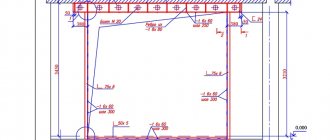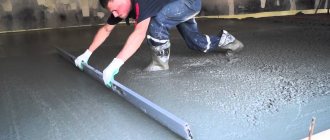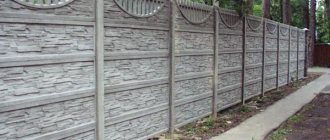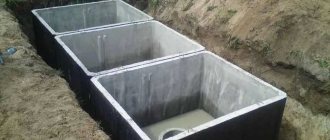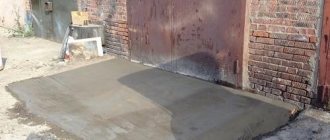Leveling the floor surface can be done using different technologies.
One of them is pouring concrete on the floor, which is not difficult to do with your own hands. Screed made from concrete mixture is used both in private housing construction and in premises whose coatings can withstand significant loads. In your home, you can install the coating yourself in the basement, garage, bathhouse, kitchen and bathroom as a base for tiles.
In private housing construction, coatings began to be poured with concrete mixture after the use of warm water floors began. The nature of pouring the mixture is determined by the presence of groundwater and the type of foundation.
Concrete floor - general information
To construct the floor in question, a concrete mixture is used - a rolling stock consisting of several components: gravel, crushed stone, sand and water. In some cases, granite or marble chips are added to the composition. The binding component in this composition is usually Portland cement.
All of the above components are mixed in certain proportions, depending on the characteristics of the crushed stone, the brand of cement, and the brand of concrete that needs to be obtained. As a result, based on the buyer’s requirements, the manufacturer can produce concrete of various classes, strengths and degrees of frost resistance.
Creation of the working staff
This composition is not difficult to create. We dilute it in water strictly according to the instructions. Mix using a drill with a special attachment. This way we get a homogeneous composition.
A simple recipe for preparing a sand-cement mixture is as follows:
- 4 shares of perlite are used. Pour 2 parts of water on them.
- Add water and cement one part at a time to the solution. Mix.
- Add two parts of sand and 10 parts of water.
- Mix the mixture until it reaches a plastic consistency.
This option is good for use in a new private home. It is also often used on the lower floors of buildings with many floors. In an apartment it is also justified if a small layer of fill is created.
Scope of application of concrete floors
We have already mentioned that concrete flooring is the most common flooring option. This also happens because the foundations of future buildings are most often built from concrete. Making a monolithic foundation, which in itself is already a foundation, eliminates the need to lay a floor. And this is a significant saving of money and time.
Typically, a concrete floor can act both as a base for finishing and as a finished coating on which furniture and appliances can be installed.
The scope of applications for concrete floors is extremely wide. This:
— floors of industrial premises and workshops. The increased strength of such foundations makes it possible to support heavy metal structures, conveyor lines and equipment involved in production processes.
— floors of large stores, warehouses and parking lots . These foundations are laid under the condition that the floor will be subject to increased loads and there will be active traffic of people and vehicles along it.
- floors in residential multi-storey and private buildings . As a rule, in multi-storey buildings made of reinforced concrete structures, the floors are concrete floors. They can be used as an element of the interior, for example, for the loft style, or you can lay a finishing coating on top of it (linoleum, laminate, ceramic tiles, parquet, etc.).
Important! We often hear that concrete floors generate dust, which means they must be covered with finishing materials. In fact, today in construction stores you can buy topping - a special mixture that strengthens the surface of the concrete floor and prevents the appearance of dust.
Mortars for perfect pouring - building mixtures or concrete? Choice
In modern conditions, pouring a floor screed with your own hands is quite feasible. And there is a large assortment of various Russian and foreign levelers on sale. These are innovative tools.
Their main specificity is that they are poured without much work with beacons and guides.
We breed them competently, using strict technology. They are affected by gravity and tension. And they are evenly distributed over the entire working surface. Cover all uneven areas and bumps. This is the easiest way to fill the floors to obtain an even, seamless and shiny finish.
There is also a classic - the use of cement compositions. They cost less. But the filling technology is more complicated. What to choose and how to fill the floors in the premises, each owner decides for himself, based on his budget, goals and scope of work.
Types of concrete floors
In a general sense, all concrete structures are divided into the following categories:
- for their intended purpose (constructive or containing special additives);
- by type of filler (cement, gypsum, slag or polymer);
- by density (light, with a density index <2000 kg/m3, or heavy, with a density index >2000 kg/m3);
- by type of filler (dense, porous or special);
- by structure (dense, cellular or large-porous).
- by the number of layers (single-layer or two-layer).
Brand and class of concrete
One of the key parameters of this material is its grade (M). This is an indicator of the strength of concrete, which experts determine in laboratory conditions, testing the finished product for compression resistance. Note also that the grade of concrete is an indicator of how much cement is present in the mixture.
For example, the concrete grade M500 indicates that a structure made from such a material can withstand pressure of 500 kg/cm3. Obviously, a higher grade indicates greater strength of the material, its faster setting and hardening.
It should be noted that the strength of concrete depends not only on the amount of cement in the composition. This indicator may be influenced by:
- quantity and quality of water in the mixture;
- weather conditions at the time of pouring the solution;
- compliance with the technology of manufacturing and pouring concrete.
To clarify the strength indicator of this material, experts introduced the concept of “concrete class”. It is designated by the letter B.
Purpose of different grades of concrete
To better understand the differences between different brands of concrete, it is worth taking a look at the scope of application of a particular brand of material. For example:
- M100 - used for preparatory work, in particular, as a footing - a thin layer of material that covers the soil before pouring the main layer of the foundation.
— M150 is another brand of concrete that is more often used in the preparatory process. Paths, blind areas of houses, as well as floor screeds are made from this material.
— M200 – is widely used for the manufacture of platforms and sidewalk paths on the street, and also finds its application in low-rise construction.
- M250 - used in the construction of multi-storey buildings for the manufacture of flights of stairs, as well as small elements of load-bearing structures.
— M300 is one of the most popular grades of concrete. It is used for the manufacture of supporting structures of multi-storey buildings, flights of stairs and floor slabs.
— M400, M450 and M500 – used for the manufacture of objects of increased reliability (subway tunnels, bunkers, bridges, swimming pools, etc.).
- M600 - used for the construction of high-strength structures, such as dams, dams or underground structures located in areas with increased seismic activity.
Frost resistance index of concrete
This indicator is designated by the letter “F” and indicates how many “freeze-defrost” cycles a product made of this concrete will withstand.
Thus, concrete with an index below F50 is used exclusively in closed premises that are not subject to freezing. In conditions of cyclical frosts, material with a frost resistance index of F50-F150 has proven itself well.
For northern latitudes, where temperatures often reach -50ºC, experts recommend choosing F300 material. Concrete with an index of F300-F500 is suitable for the construction of facilities in extremely cold operating conditions.
Water permeability index of concrete
When choosing concrete, you should also pay attention to its water permeability, indicated by the letter “W”. This indicator depends on how porous the concrete is. The higher the porosity, the greater its water permeability. For example, for aerated concrete this figure can reach 25%.
Important! To increase the frost resistance and moisture resistance of concrete, manufacturers add various modifiers and plasticizers to the composition. And during the process of pouring the mixture, workers must perform compaction using vibrators. This avoids the formation of air voids inside the concrete, which can fill with moisture.
Types of concrete by type of binder
The physical characteristics of the material in question largely depend on the binding component. In this regard, concretes are as follows:
1. Cement. This is the most common and most in demand material. It is widely used for the manufacture of screeds during construction work, both indoors and outdoors. As a rule, the binding component is Portland cement.
2. Special. To improve the characteristics of the material, various components can be added to cement concrete. The strength of such a floor is ensured by the addition of fine shavings, heat resistance is ensured by the addition of magnesite, and protection from radioactive radiation is ensured by the addition of barite.
3. Reinforced concrete. To obtain a reinforced concrete structure, a welded reinforced frame is poured with the finished concrete mixture.
4. Slag-alkali. The composition of this material includes crushed slag. The addition of an alkaline component improves the technical characteristics of the material, increasing its frost resistance and water resistance. In addition, the use of slag allows for the disposal of production waste, which means that this type of material is considered the most promising option for the development of the construction industry.
5. Aerated concrete. The technology for producing aerated concrete using the autoclaving method makes it possible to obtain a porous material that has low thermal conductivity.
6. Foam concrete. Another option for obtaining a material with low thermal conductivity. For this purpose, manufacturers foam the cement mixture.
7. Fiber-reinforced concrete. When additional strengthening of the screed being formed is necessary, fiber fibers are added to the concrete mix. This can be fiberglass, asbestos, basalt, and in some cases, pieces of steel wire. Practice shows that thanks to the listed additives, the strength of a concrete floor can be increased by almost 30%.
Important! Experts advise adding fiberglass to the mixture when pouring screeds under overly loaded or heated floors.
8. Wood concrete. This material is also called wood concrete. During production, wood shavings are added to the cement mixture, which makes the material warm. The only negative is that it begins to absorb moisture more strongly.
9. Kevlar concrete. This version of concrete involves adding granite or marble chips, as well as liquid glass, to the solution. As a result, the hardened concrete floor begins to resemble a slab of natural stone.
10. Polymer-cement. In this case, resins and other polymer fillers are diluted in the concrete mixture. Thanks to such additives, a more durable structure with increased water resistance is obtained.
11. Silicate. This material is made on the basis of silica using autoclave temperature treatment. This allows you to create extremely durable concrete.
12. Plaster. For interior finishing work, environmentally friendly gypsum concrete is often produced. Various plasticizers can be added to such a material to improve its characteristics.
Briefly about the soil foundation
Before you decide to make your own home floors from scratch cheaply, you need to consider options for protecting the floor from the natural effects of the earth. These include changes in humidity with temperature, seasonal movement of the formation at the freezing depth, and gas release.
Almost every person is familiar with the first two facts. Here, a mineral substrate, a water barrier and a thermal insulation sheet are installed as the main protection. Gases are often forgotten.
Chemical processes in the bowels of the earth occur continuously. Among them is the breakdown of radioactive substances, which are also contained in sand, clay, and crushed stone. As a result, radon gas is formed - an inert substance that tends to have an irradiating effect. Since it has a density higher than that of air, there is a cumulative effect inside a closed space. Concrete is breathable, so it is important to create protective barriers for harmful substances.
Radioactive gas Source townsquare.media
Advantages of concrete floors
1. Popularity and accessibility. Concrete flooring is without a doubt the most affordable and most popular type of surface covering. Private homes and commercial sites, warehouses and industrial facilities - concrete floors are used everywhere. This is largely influenced by the availability of the incoming components of concrete - gravel, crushed stone, cement and sand. In fact, to build a concrete floor of a small area, a person can pour such a floor with virtually no material costs.
Important! Statistics show that more than 20 billion tons of concrete mixtures are produced annually in the world!
2. Durability. Concrete floors also impress with their durability. If the technology for laying this flooring is followed, and normal operating conditions (indoors), such a floor will last 20-30 years. Moreover, with periodic minor repairs (every 5-7 years), this coating will last even longer.
3. Environmental friendliness. All components of a concrete floor, including cement, sand and crushed stone, are of natural origin, which means they are environmentally friendly and not harmful to humans. This composition does not contain harmful toxic additives, which means that such floors can be poured for absolutely any premises, including those in which people live.
4. Durability. A huge advantage of the material in question is its strength. Hardened concrete actually turns into stone, and therefore this floor is not afraid of mechanical influences - shocks, friction or vibrations. Even severe loads and strong impacts do not lead to cracks in a concrete floor.
5. Resistant to water. An extremely important advantage of a concrete floor over other flooring is the ability of this material not to deteriorate under the influence of water and high humidity. Moreover, this floor is resistant to oils and aggressive chemicals, which allows it to be poured in production workshops and warehouses. Even with prolonged exposure to aggressive environments, such a base does not deform or collapse.
6. Heat resistance. Most known materials, such as wood, are highly flammable and burn well. Concrete in this regard is a pleasant exception, since this floor simply cannot be set on fire. It does not burn or smolder, does not cause smoke and does not produce asphyxiating gas. We can say that this is one of the safest materials for making floors.
7. Frost resistance. The cement from which concrete is made has a high frost resistance coefficient. And this is an extremely important quality, thanks to which a floor made of this material can easily withstand harsh winters and sudden temperature changes.
Important! Before purchasing cement, it is important to pay attention to the number of cycles that the concrete made from it will be able to withstand. The durability of your foundation will largely depend on this indicator.
8. Solidity. Unlike other types of bases, a concrete floor is made of a liquid composition, which, after hardening, hardens, turning into one monolithic platform. It has no seams, which means it does not dry out and has no cracks. This feature saves builders from many problems typical for other floors.
9. Strong adhesive properties. In addition to the listed advantages, such a floor adheres perfectly to finishing coatings, for example, polymers, essentially turning into a single structure.
10. Saving time and effort. Pouring such a floor, if you have a concrete mixer, will not take much time. And with the use of a manual concrete mixer, the process of creating a concrete base does not look like a very difficult task.
Important! Currently, construction companies are ready to offer ready-mixed concrete at a reasonable price. When you order, a concrete mixer will deliver the finished product directly to your site and pour it into pre-prepared formwork.
Creation of formwork. Working with Guides
We lay the concrete floor in parts - cards. These are rectangular areas. Their parameters are determined by two factors:
- Total surface area.
- Possibility of filling the composition in one working cycle.
We place formwork along the perimeter of these areas to mark the finished floor. It is created from a 5 x 10 cm board. We pre-drill holes in the boards for reinforcing pins with a distance of 50 cm. We apply the formwork lines to the seam pattern.
We fill the floor in a new house along the guides. We can use them as:
- metal profiles,
- steel corners 5 x 5 x 0.3 cm,
- profile pipe 4 x 2 x 0.2 cm.
We mount the guides by welding to reinforcement posts with a diameter of 1.2 cm. To control the evenness, we use an optical level.
All areas where the surface is adjacent to the load-bearing components are covered with Izolon with a density of 4 mm. This is a damper tape based on polyethylene foam.
So we fill the floor in parts. Just before filling, we treat all profiles with engine oil. And we moisten the rough base with water.
Have questions ? Call!
Disadvantages of concrete floors
This material also has some disadvantages that should also be taken into account.
1. High thermal conductivity. Concrete easily transmits heat, and therefore heat can leave the room through such a floor. To prevent this from happening, when installing such a frame, a layer of insulation (sheet or granular) should be laid. And to ensure the most comfortable living conditions, a heated floor should be laid under the concrete screed.
2. High consumption of materials. Compared to other flooring materials, a concrete screed requires quite a lot of concrete mixture to form. Making batches manually with such volumes is quite problematic, and therefore you have to order a concrete mixer. And these are additional financial expenses.
3. Large weight of the floor. It should be noted that this material produces a rather heavy floor, which means it will create an increased load on the foundation.
4. Duration of hardening of the floor. This screed takes quite a long time to harden. The duration will depend on the strength of the concrete, but in general it can take from 3 to 28 days.
Pouring process
How to fill the surface of an existing base more efficiently? If all measures for leveling have already been provided, then the process should be completed in one day. This is the key to uniform composition.
Filling begins from the far corner of the room. To level the layer, apply the rule. We evenly distribute the material within the boundaries of the fixed beacons.
Using a needle roller, remove air from the mixture. This way we exclude the occurrence of internal voids in it. Then we level the screed completely. We repeat the operations until the base is completely filled.
If you have some misunderstandings, you can watch a video of how to pour a floor screed with your own hands.
Concrete floor installation technology
Pouring a concrete floor is not the most difficult process. However, a person who does not have such experience will not be able to install such a base. It is important to take into account the nuances on which the quality, strength and durability of the structure will depend. Next, we will consider the technology of pouring the floor in question.
1. Geodetic works. The formation of such a basis begins with geodetic measurements. It is important to determine the topography of the soil, measure the floor level and calculate the thickness of the poured concrete. Based on the readings received, the specialist will be able to calculate the building material.
2. Preparing the base. Depending on the base on which the floor in question will be poured, different requirements are imposed on it. For example:
- before pouring a monolithic base onto the ground, it must first be prepared by removing the soil and compacting the soil well. A so-called “sand cushion” with a thickness of 0.5 to 1 meter should be laid on top. This layer should also be compacted, and only then can you begin pouring the concrete mixture. Otherwise, such a floor may crack.
— in the case of pouring a floor onto an existing monolithic base, such a base must be examined for cracks and, if necessary, cemented or filled with polymer mixtures. Possible unevenness on the surface is also eliminated with a cement-sand mixture, after which the base must be sanded.
3. Laying waterproofing. A waterproofing film or polymer membrane must be laid on the prepared base. This is necessary so that moisture does not quickly leave the concrete mixture after pouring. This can cause the floor to dry out and crack.
4. Installation of formwork. Formwork is the form that will be filled with concrete mixture during the process of forming the floor. In the absence of a concrete mixer, such a floor is poured in rectangles, which are called “cards”. Formwork is installed around the perimeter of each card.
5. Installation of reinforcement cage. To increase the reliability and durability of the concrete screed, before pouring, builders lay a reinforcing mesh or weld a reinforcement cage. The dimensions of the mesh or the dimensions of the frame, including the thickness of the reinforcement, depend on the size, thickness, and requirements for the floor.
6. Pouring concrete. The installation of the concrete base should be carried out using a concrete mixer, because it is advisable to fill such a floor in one go. In cases where special equipment is not able to get directly to the installation site, specialists use a concrete pump.
Important! The strength of the future foundation largely depends on the pace of work performed. The faster the floor is poured, the stronger it will be.
7. Distribution and compaction. The concrete mixture poured into the formwork must be evenly distributed around the perimeter, and then manipulations must be performed that will help compact it. For this purpose, special devices are used - a sealing vibrator, and then a vibrating screed. The compacting vibrator creates vibrations in the thickness of the poured mixture, expelling air bubbles from it. A vibrating screed is used to level the concrete.
8. Grout. After filling the floor and compacting it, you need to leave the material for a while so that it sets. After approximately 6-7 hours, you can take a special concrete finishing machine (“helicopter”) and start grouting. It is recommended to perform this procedure several times at intervals of several hours.
9. Freezing. The poured floor should be left alone for several days, allowing it to harden a little, but not dry completely.
10. Cutting seams. In case of increased loads on the floor, experts recommend cutting the flooring into equal slabs. This process is necessary in order to avoid cracking of the monolithic concrete slab during operation. To do this, a specialist, using an angle grinder and a diamond disc mounted on it, cuts the concrete floor into pre-marked squares, maintaining a certain depth.
Important! Cutting should be done 24 hours after pouring the concrete, when the mixture has already hardened sufficiently, but no later than 72 hours. This is important because if you cut material that is too dry, it may start to crack.
11. Filling seams. After cutting, an insulating compound is poured into the cuts to the entire depth of the screed. This prevents water and various contaminants from entering the concrete floor.
We can conclude that concrete floors are a cost-effective solution for people who are constructing a building for many years. For a low price and with a minimum of physical costs, you get a strong and reliable foundation that will serve you for decades!
Installation of a wooden floor: technology, photo, installation
Self-leveling floor in an apartment and its features
Laying the finishing screed
The technology for installing concrete floors involves laying a finishing screed. It is this that will serve as the outer surface after grinding or act as the basis for decorative finishing material.
The sequence of work for pouring the finishing screed:
- Reinforcement
- use road mesh or steel rods with a diameter of 8 millimeters (in 1-2 layers, 2-4 in a bundle - it all depends on the thickness of the fill and the loads that will affect the floor).
- Installation of beacons
– the slats are mounted at a distance of 2 meters from one another in such a way that the ends of the rule can be supported on them.
- Pouring concrete
– it is better to use an already prepared solution, which is fed through the hose in its entirety at once. Usually they are poured 15 millimeters above the beacons.
- Careful leveling
, compaction of concrete using a rule or vibrating screed.

